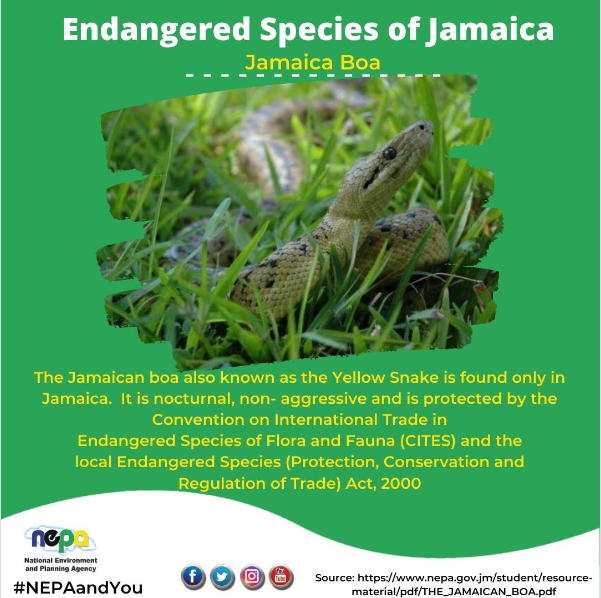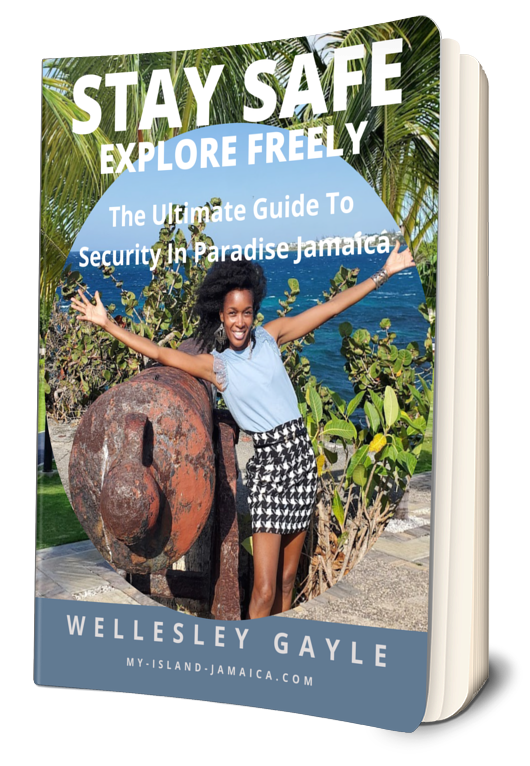Subscribe for all my updates and don't miss a thing! Sign me up!
Jamaican Endangered Species
12 Species at the Risk of Going Extinct
Sharing Is Caring! Share this awesome content with your friends now.
 Endangered Species Of Jamaica
Endangered Species Of JamaicaBy Venesha Johnson | Associate Writer
Jamaica, our tropical jewel of the Caribbean, is renowned for its stunning landscapes, vibrant culture, and diverse flora and fauna. However, hidden within this paradise lies a sobering reality: several of Jamaica's endemic species are critically endangered. These unique creatures, found nowhere else on Earth, face numerous threats that have pushed them to the brink of extinction.
New! Take a piece of Jamaica with you💃!
Savour the memories! Now you can get your authentic Jamaican souvenir items, as well as traditional Jamaican herbs, spices and housewares on our popular e-store. Click Here to learn more.
And, if you ever need a trustworthy and knowledgeable local guide, consider booking a private tour with us!
Sadly, Jamaica has close to 300 species of animals and plants considered endangered, the 13 below are barely scratching the surface.
1. Jamaican Iguana
One of the most iconic and critically endangered species in Jamaica is the Jamaican Iguana (Cyclura collei). Once considered extinct, this magnificent reptile made a surprising comeback in the 1990s. With fewer than 100 remaining in the wild, the Jamaican Iguana faces ongoing challenges such as habitat destruction, predation, and poaching.
Efforts to save the Jamaican Iguana include captive breeding programs, habitat restoration, and public awareness campaigns. The Hope Zoo is among the institutions dedicated to protecting and breeding these iguanas, with hopes of eventually reintroducing them into their natural habitats.
2. Blue Mountains Swallowtail Butterfly
Another unique and threatened species found only in Jamaica is the Blue Mountains Swallowtail Butterfly (Papilio homerus). As the largest butterfly in the Western Hemisphere, it is a truly magnificent creature. However, its habitat in the Blue and John Crow Mountains is under constant pressure from deforestation, climate change, and illegal collecting for the butterfly trade.
Conservation organizations and the Jamaican government are working to protect the Blue Mountains Swallowtail Butterfly by establishing protected areas and implementing sustainable land-use practices. Public education programs emphasize the butterfly's ecological importance, hoping to inspire local communities to become stewards of its habitat.
3. Jamaican Boa
The Jamaican Boa (Epicrates subflavus) is a non-venomous constrictor that is found exclusively on the island of Jamaica. Once abundant throughout the country, its population has drastically declined due to habitat loss, persecution by humans, and the introduction of invasive predators such as the mongoose.
Conservation initiatives for the Jamaican Boa focus on habitat protection, raising awareness about its ecological role, and mitigating human-wildlife conflicts. These efforts aim to prevent the further decline of this unique species and restore its population in key areas.
4. Black-billed Amazon Parrot
The Black-billed Amazon Parrot (Amazona agilis) is a striking and intelligent bird found in Jamaica's forests. Habitat loss, illegal capture for the pet trade, and natural disasters have greatly reduced its population. Conservation efforts involve protecting nesting sites, enforcing trade regulations, and promoting sustainable forestry practices to preserve the parrot's habitat.
5. Jamaican Slider Turtle
Endemic to Jamaica, the Jamaican Slider Turtle (Trachemys terrapen) faces numerous threats, including habitat destruction, pollution, and the introduction of non-native species. Conservation initiatives focus on habitat restoration, raising awareness, and implementing measures to prevent the spread of invasive predators.
6. Jamaican Poorwill
The Jamaican Poorwill or Pauraque (Siphonorhis americanus) is a nocturnal bird known for its distinctive call. Habitat loss and predation by introduced species have led to its decline. Conservation efforts involve protecting nesting grounds, controlling predators, and promoting sustainable tourism practices that minimize disturbance to their habitats. This last recorded sighting was in the 1860’s so it is classified as extinct, however, some are of the opinion that the bird is still around.
7. Jamaican Yellow Boa
The Jamaican Yellow Boa (Chilabothrus flaviventris) is a threatened snake species found exclusively in Jamaica. Its population has suffered due to habitat degradation, persecution, and road mortality. Conservation initiatives aim to protect its habitat, raise awareness, and conduct research to better understand its ecological needs.
8. Jamaican Fruit Bat
The Jamaican Fruit Bat (Artibeus jamaicensis) is an important pollinator and seed disperser in Jamaica's ecosystems. Habitat loss, hunting, and pesticide use threaten its survival. Conservation efforts involve promoting bat-friendly agricultural practices, preserving roosting sites, and educating communities about the ecological importance of these bats.
9. Jamaican Streamertail
The Jamaican Streamertail (Trochilus polytmus) is a stunning hummingbird species endemic to Jamaica. Habitat loss, climate change, and competition from invasive species are endangering its populations. Conservation initiatives include protecting its habitat, creating pollinator-friendly gardens, and reducing pesticide use to ensure its survival.
10. Jamaican Yellow-billed Parrot

The Jamaican Yellow-billed Parrot (Amazona collaria) is a highly endangered parrot species found only in Jamaica's forests. Habitat loss, illegal capture, and disease transmission pose significant threats. Conservation efforts involve habitat restoration, anti-poaching measures, and community-based initiatives that provide alternative livelihoods to local communities.
11. Jamaican Bromeliad Crab
The Jamaican Bromeliad Crab (Metopaulias depressus) is a unique land crab that depends on bromeliads for shelter and survival. Habitat destruction and climate change are impacting their populations. Conservation efforts focus on protecting bromeliad habitats, controlling invasive predators, and promoting sustainable land management practices.
12. Jamaican Coney
On our island is a small, endangered rat-like creature known as the Jamaican Coney (Geocapromys brownii), commonly referred to as the Jamaican hutia or Brown's hutia. The government has implemented strategies for it's conservation such as illegalizing the hunting and capturing of this species.
Sharing IS Caring! Please help me get the message out by sharing this article with your friends on social media (links below). Thnx ;-)
If you found this page useful, please consider subscribing to my weekly newsletter, to get even more.
It tells you each week about the new information that I have added, including new developments and great stories from lovers of Jamaica!
Return to Jamaican Wildlife and Nature from Jamaican Endangered Species
Return to My Island Jamaica Homepage from Jamaican Endangered Species
References & Sources For Jamaican Endangered Species
- Endangered species of Jamaica - List - Earth’s Endangered Creatures. (n.d.). Endangered Species of Jamaica - List - Earth’s Endangered Creatures. http://www.earthsendangered.com/search-regions3.asp?mp=&search=1&sgroup=allgroups&ID=180
- NEPA appeals to Jamaicans to stop hunting conies. (2023, May 18). Jamaica Observer. https://www.jamaicaobserver.com/news/nepa-appeals-to-jamaicans-to-stop-hunting-conies/
New! Get My Latest Book👇🏿
|
You asked, I've answered! You no longer need to save for months or years, to enjoy paradise! I spilled the beans! sharing my top tips on finding cozy accommodations and secret gems, only the way a native could! Click Here to pick it up on my e-store and start saving now! |
See The Best Of Jamaica - In Videos!
|
My channel reaches over 140,000 subscribers worldwide and has leveraged over 11 million views, sharing, what I call 'The Real Jamaica'. Subscribe today and join our family of viewers. |
Read More ...
New! Experience The REAL Jamaica!
Book Your Private Tour here and experience Jamaica the way we (locals) do!
P.S. Didn't find what you were looking for?
Still need help?
Click Here to try our dependable and effective Site Search tool. It works!
Or, simply click here and here, to browse my library of over 500 questions and answers! Chances are someone already asked (and got an answer to) your question.
















New! Comments
Have your say about what you just read! Leave me a comment in the box below.